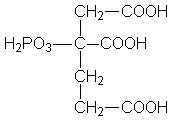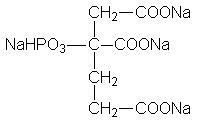| 2-Phosphonobutane-1,2,4-Tricarboxylic Acid(PBTCA)
PBTCA
CAS No.: 37971-36-1
Dequest: 7000
Molecular weight: 270.13
Molecular Formula: C7H11O9P
Structural Formula:
PBTCA·Na4
CAS No.: 40372-66-5
Dequest: 7006
Molecular weight: 358
Molecular Formula: C7H7O9P·Na4
Structural Formula:
Properties:
PBTCA has low content of phosphoric, has structural features of both phosphoric acid and carboxylic acid group, which enable its excellent scale and corrosion inhibition properties. Its antiscale property under high temperature is far better than that of organophosphines. It can improve zinc salt solubility, has good chlorine oxidation tolerance and good composite synergy.
Specification:
Items |
Index |
PTBCA |
PBTCA·Na |
Appearance |
Colorless or light yellow transparent liquid |
White powder |
Active acid (PBTCA) % |
50.0min |
67.0-73.0 |
Active component (PBTCA·Na4) % |
|
88.8-96.8 |
Phosphorous acid (as PO33-) % |
0.8max |
|
Phosphoric acid (as PO43-) % |
0.5max |
23.5-25.5 |
Fe (as Fe3+) ppm |
|
35max |
Density (20℃) g/cm3 |
1.27min |
|
PH (1% water solution) |
1.5-2.0 |
6.5-8.0 |
Usage:
PTBCA is a high efficient agent as scale and corrosion inhibitor. It is the excellent stabilizer for zinc salt. It is widely used in circulating cool water system and oilfield refill water system as scale and corrosion inhibitor, suitable to composite with zinc salt and copolymer. It can be used in situations of high temperature, high hardness, high alkali and high conc-entration index. In lavation fields, it is used as chelating agent and metal detergent.
PBTCA is usually used together with zinc salt, copolymer, organophosphine, imidazole and other water treatment agents. When used alone, the dosage of 5-15mg/L is preferred.
Package and Storage:
PTBCA liquid: Normally In 250kg net Plastic Drum, IBC drum can also be used as required.
PTBCA solid: 25kg inner liner polyethylene (PE) bag, outer plastic woven bag, or confirmed by clients.
Storage for ten months in room shady and dry place.
Safety Protection:
Acidity, Avoid contact with eye and skin, once contacted, flush with water.
|

